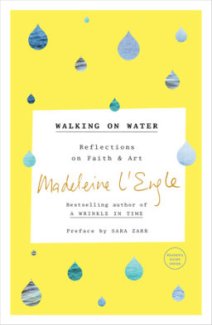 In one sense, Madeleine L’Engle’s “Walking on Water: Reflections on Faith and Art,” was pleasant to read and stroked my ego as as a wanna-be writer. Parts of it were inspiring. Overall, however, I found it insipid and overly foofy; it talks of writing and art in the loftiest of idealistic prose, as the highest reaches of human meditation and striving.
In one sense, Madeleine L’Engle’s “Walking on Water: Reflections on Faith and Art,” was pleasant to read and stroked my ego as as a wanna-be writer. Parts of it were inspiring. Overall, however, I found it insipid and overly foofy; it talks of writing and art in the loftiest of idealistic prose, as the highest reaches of human meditation and striving.
In a sense, I agree with most of it. But an idealization of the writing vocation is only a tenth of the story. The other nine-tenths are work, the basic discipline of hitting the nail with the hammer every single day. In this sense, it’s like any other skill or job, one where talent and know-how deepen as experience progresses.
Here’s an example of what I didn’t like:
“The world of fairy tale, fantasy, myth, is inimical to the secular world, and in total opposition to it, for it is interested not in limited laboratory proofs but in truth.” (46)
I love fairy tales and fantasy far more than the average fellow, but science is not something to dismiss. I am not a scientist, but I suspect that a tech-minded reader might react defensively, “Hey that’s what my lab tests are all about–truth.” Of course scientific methodology excludes philosophy, meta-narrative claims, but the whole purpose is to learn true things about how the universe works in order to understand it better. This mentality oversteps when we view ourselves as masters of the universe, meant to tame it. But in general, I would say science and laboratory experiments are at the service to truth, a different approach to understanding our world. I think it throws the baby out with the bathwater to pit science in opposition to truth, as if creative types have some sort of lock on that.
Then there was this:
“In art, we are once again able to do all the things we have forgotten; we are able to walk on water; we speak to the angels who call us; we move, unfettered, among the stars.” (47)
Bleck. I am an idealistic person, and I am sympathetic to what she is getting at, which I take to be that art or creativity is an attempt at knowing or expressing truth. Seeking the fullness of truth can be understood as a sort of prayer or connection with reality aka God. That striving to speak truth can bring the speaker to the heights of human calling.
But. I find L’Engle’s language so over-the-top as to discredit it. It’s as if she divinizes the artist himself rather than showing him as a mere human glimpsing at participation with the divine–which is really the intention. Much of life, and I suspect much of an artist’s life, is spent in murky misunderstanding, darkness and trials, and the prosaic daily activities of buying materials, preparing food and changing sheets. Even the highest peaks of sublimity in creation pass unnoticed because the artist is so absorbed in the act. Never is she really conscious of “moving unfettered among the stars.” Maybe L’Engle is, and that sounds amazing.
But the work of other writers and artists, such as Stephen King and Flannery O’Connor, who have explained their craft, spend more time focusing on the process, on the work, of being surprised by the product despite their best plans. So while the artist does do some amazing co-creation, it is rather unknowable. My concern is not that L’Engle is wrong, but that the tone is deceptive.
Artists are not really a breed set apart for transcendental experience, but rather fellow stumblers along the road. More accurate would be Oscar Wilde who said, “We are all lying the gutter, but some of us are looking at the stars.” Continue reading

